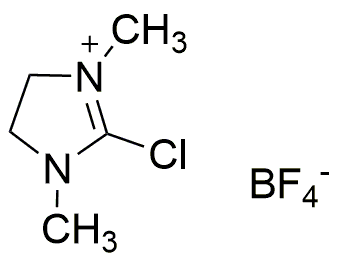2-Chloro-1,3-dimethylimidazolinium tetrafluoroborate is widely utilized in research focused on:
- Organic Synthesis: This compound serves as a versatile reagent in organic chemistry, facilitating the synthesis of various complex molecules, particularly in the development of pharmaceuticals.
- Electrolyte in Energy Storage: It is used as an electrolyte in lithium-ion batteries, enhancing conductivity and improving overall battery performance, which is crucial for the renewable energy sector.
- Catalyst in Chemical Reactions: The compound acts as a catalyst in numerous chemical reactions, streamlining processes in the chemical manufacturing industry and reducing production costs.
- Material Science: It finds applications in the development of advanced materials, such as polymers and nanomaterials, which are essential in electronics and nanotechnology.
- Biochemical Applications: Researchers utilize it in biochemical assays and studies, particularly in exploring enzyme activities and interactions, contributing to advancements in biotechnology.
General Information
Properties
Safety and Regulations
Applications
2-Chloro-1,3-dimethylimidazolinium tetrafluoroborate is widely utilized in research focused on:
- Organic Synthesis: This compound serves as a versatile reagent in organic chemistry, facilitating the synthesis of various complex molecules, particularly in the development of pharmaceuticals.
- Electrolyte in Energy Storage: It is used as an electrolyte in lithium-ion batteries, enhancing conductivity and improving overall battery performance, which is crucial for the renewable energy sector.
- Catalyst in Chemical Reactions: The compound acts as a catalyst in numerous chemical reactions, streamlining processes in the chemical manufacturing industry and reducing production costs.
- Material Science: It finds applications in the development of advanced materials, such as polymers and nanomaterials, which are essential in electronics and nanotechnology.
- Biochemical Applications: Researchers utilize it in biochemical assays and studies, particularly in exploring enzyme activities and interactions, contributing to advancements in biotechnology.
Documents
Safety Data Sheets (SDS)
The SDS provides comprehensive safety information on handling, storage, and disposal of the product.
Product Specification (PS)
The PS provides a comprehensive breakdown of the product’s properties, including chemical composition, physical state, purity, and storage requirements. It also details acceptable quality ranges and the product's intended applications.
Certificates of Analysis (COA)
Search for Certificates of Analysis (COA) by entering the products Lot Number. Lot and Batch Numbers can be found on a product’s label following the words ‘Lot’ or ‘Batch’.
*Catalog Number
*Lot Number
Certificates Of Origin (COO)
This COO confirms the country where the product was manufactured, and also details the materials and components used in it and whether it is derived from natural, synthetic, or other specific sources. This certificate may be required for customs, trade, and regulatory compliance.
*Catalog Number
*Lot Number
Safety Data Sheets (SDS)
The SDS provides comprehensive safety information on handling, storage, and disposal of the product.
DownloadProduct Specification (PS)
The PS provides a comprehensive breakdown of the product’s properties, including chemical composition, physical state, purity, and storage requirements. It also details acceptable quality ranges and the product's intended applications.
DownloadCertificates of Analysis (COA)
Search for Certificates of Analysis (COA) by entering the products Lot Number. Lot and Batch Numbers can be found on a product’s label following the words ‘Lot’ or ‘Batch’.
*Catalog Number
*Lot Number
Certificates Of Origin (COO)
This COO confirms the country where the product was manufactured, and also details the materials and components used in it and whether it is derived from natural, synthetic, or other specific sources. This certificate may be required for customs, trade, and regulatory compliance.


